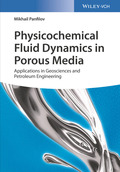Physicochemical Fluid Dynamics in Porous Media
Applications in Geosciences and Petroleum Engineering

1. Edition January 2019
XXII, 371 Pages, Hardcover
228 Pictures (80 Colored Figures)
Monograph
Short Description
A timely overview of all flow and transport processes in which chemical or physico-chemical phenomena are essential, bringing together theoretical and experimental results previously scattered throughout the literature. Includes important industrial applications.
Buy now
Price: 159,00 €
Price incl. VAT, excl. Shipping
Euro prices for Wiley-VCH and Ernst & Sohn titles are only valid for Germany. In EU countries, local VAT applies. Postage will be charged.
A unique and timely book on understanding and tailoring the flow of fluids in porous materials
Porous media play a key role in chemical processes, gas and water purification, gas storage and the development of new multifunctional materials. Understanding hydrodynamics in porous media is decisive for enabling a wide range of applications in materials science and chemical engineering. This all-encompassing book offers a timely overview of all flow and transport processes in which chemical or physicochemical phenomena such as dissolution, phase transition, reactions, adsorption, diffusion, capillarity, and surface phenomena are essential. It brings together both theoretical and experimental results and includes important industrial applications.
Physicochemical Fluid Dynamics in Porous Media: Applications in Geoscience and Petroleum Engineering explains the thermodynamics of phase equilibria for multicomponent fluids, physicochemical models of single-phase and immiscible two-phase flow, based on the macroscopic theory of oil displacement by water. It also covers the theory of two-phase flow with partial miscibility and describes partially miscible flows with phase transitions by means of the negative saturation approach. The final chapters are devoted to flow with chemical reactions, based on the example of in-situ leaching of uranium, and flow with bio-chemical reactions in terms of the underground storage of hydrogen.
-Brings together the theoretical and experimental results necessary for the understanding of hydrodynamics in porous media
-Covers important industrial applications such as underground leaching of uranium and underground storage of hydrogen
-Presents a state-of-the-art overview and summarizes the research results usually found only scattered in the literature
Physicochemical Fluid Dynamics in Porous Media: Applications in Geoscience and Petroleum Engineering will appeal to chemical engineers, materials scientists, applied physicists, and mechanical engineers.
Equilibrium of Single-Phase Fluids. Equation of State
Two-Phase Equilibrium of Mono-Component Fluids
Chemical Potential of Ideal Gas Mixture
Chemical Potential of Non-Ideal Mixtures
Two-Phase Equilibrium of Two-Component Fluids
Equilibrium of Multi-Component Phases
Comparison with Experimental Data
Equilibrium in Diluted Mixtures
PASSIVE TRANSPORT
General Equations of Passive Transport
Conservation Equations
Convective Transport
Diffusion Transport
Properties of Diffusion Parameters
Properties of the Diffusion Transport
Convection-Diffusion Transport
TRANSPORT WITH ADSORPTION
Adsorption Phenomenon and Model
Transport with Adsorption: General Equations
TRANSPORT WITH CHEMICAL REACTIONS
Description of a Chemical Reaction
Particle Balance in a Reaction
Kinetics of a Reaction
Transport with Reactions
Example 2: In-Situ Leaching of Uranium Ores
SURFACE AND CAPILLARY PHENOMENA
Surface Properties
Wetting
Movement of the Triple Line
MICRO-MECHANICS OF FLOW IN POROUS MEDIA
Capillary Phenomena in a Pore
Structure of Phase Clusters in Pore Networks
TRANSITION TO MACROSCALE TWO-PHASE EQUATIONS
Geometrical Method
PORES-SCALE HYDRODYNAMICS: THEORY OF RELATIVE PERMEABILITY
Bethe-Tree Model for Relative Permeability of Stochastic Networks
MACROSCALE THEORY OF IMMISCIBLE TWO-PHASE FLOW
Fundamental Equations of Two-Phase Immiscible Flow
Canonical Theory of Horizontal Two-Phase Displacement
Displacement with Gravity
THEORY OF PARTIALLY MISCIBLE TWO-PHASE DISPLACEMENT
Phase Diagrams for Three-Component Mixtures
Model of Two-Phase Three-Component Flow in Porous Media
Regimes of Oil Displacement
Chemical Flooding
METHOD OF NEGATIVE SATURATIONS FOR TWO-PHASE FLOW WITH PHASE APPEARANCE AND DISAPPEARANCE
Interface of Phase Disappearance
Hydrodynamic and Thermodynamic Model of the Process
Method NegSat
Qualitative Analysis of the Method for Diffusion-Free Flow
Qualitative Analysis of the Method for Flow with Diffusion
Simulation of 2D Flow: Collision of PT-Interfaces
Reduction to VOF-Method for Immiscible Fluids
EXTENSION OF THE METHOD NegSat TO THREE-PHASE MULTICOMPONENT FLOW
Method NegSat for any Number of Phases
Extension of the Equivalence Principle to Complex Cases
Principle of Equivalence between Two-Phase and Three-Phase Fluids
Numerical Simulation of Three-Phase Flow
2D Three-Phase Simulations without Gravity
REACTIVE TRANSPORT IN THE UNDERGROUND LEACHING OF URANIUM
Introduction
Model of Transport with Heterogeneous Reactions and Colmatation
Asymptotic Solution of 1D Problem
Comparison with Experimental Data
SELF-ORGANIZATION AND SHOCK WAVES IN UNDERGROUND STORAGE OF HYDROGEN
Underground Hydrogen Storage as an Element of an Energy Cycle
Bio-Chemical Problems Related to UHS
Hydrodynamic Processes in UHS: Gas-Water Flow in Presence of Bio-Reactions
Shock Waves in the Case of Instantaneous Bio-Reactions
Self-Organization for Non-Instantaneous Kinetics
Self-Organization in Presence of Chemotaxis


